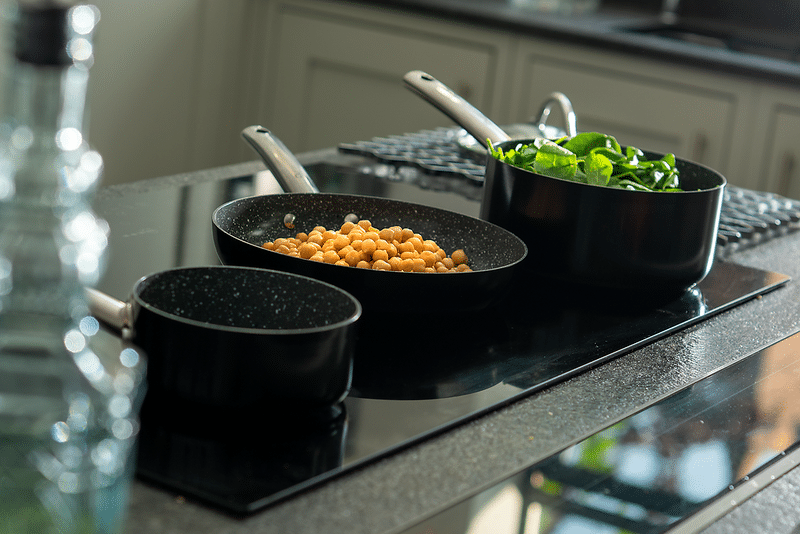When it comes to choosing the right cookware for your kitchen, there are many factors to consider, including material, durability, and heat distribution. Two of the most popular kitchen cookware options are hard anodised and stainless steel cookware.
In this blog post, Kitchenways explores the differences between hard anodised and stainless steel cookware, from composition to maintenance and everything in between. We’ll also examine the benefits and disadvantages of each type of cookware to help you decide which one is right for your kitchen. Whether you’re an experienced cook, this post will provide you with valuable insights into the world of cookware. So, let’s dive in!
Tip: If you want to know more about hard anodised cookware specifically, read our recent blog.
Differences Between Stainless Steel & Hard Anodised Cookware
There are a number of important differences between these cookware types across a range of factors. Here are the important elements of cookware and how stainless steel differs from hard anodised cookware in each:
- Composition
Stainless steel cookware is made from a combination of metals, typically including steel, aluminium, and sometimes copper or titanium. On the other hand, hard anodised cookware is made from aluminium that has been electrochemically treated to create a hard, non-reactive surface.
- Durability:
Because of its composition, hard anodised cookware is more durable than stainless steel cookware. The electrochemical treatment used to create the hard anodised surface makes it more resistant to scratches, dents, and other types of damage. That is not to say that stainless steel isn’t durable, but it can be prone to scratches and dents.
- Heat conductivity:
Stainless steel cookware can have hot spots that cause uneven cooking, as stainless steel is not ideal for even heat conduction. Hard anodised cookware, on the other hand, has excellent heat conductivity, which allows for even cooking throughout the pan.
- Non-reactive surface:
Hard anodised cookware boasts a non-reactive surface that prevents it from reacting with acidic or alkaline foods, making it the perfect option for preparing dishes with ingredients such as tomatoes, citrus fruits, or vinegar. While stainless steel cookware is typically non-reactive, it may not be the most suitable choice for cooking acidic foods over prolonged periods.
- Maintenance:
Stainless steel cookware is easy to clean and maintain. It can simply be added to the dishwasher and is resistant to rust and corrosion. Hard anodised cookware is also easy to clean but may require a little more care. Preferably, it should be washed by hand, and abrasive sponges or cleansers should be avoided.
Uses of Stainless Steel Cookware vs Hard Anodised Cookware
With all the differences outlined above, you can imagine that these options are ideal for cooking different types of foods. So let’s take a look at what you can make with each so that you can consider your favourite meals and which cookware option will make them the best.
Stainless Steel Cookware Uses
Stainless steel cookware is versatile and can be used to cook a wide range of foods. This type of cookware is ideal for making:
- Boiled or steamed vegetables
- Rice, pasta, and grains
- Meats such as steak, chicken, and fish
- Soups and stews
- Stir-fry dishes
- Sauces and gravies
Hard Anodised Cookware Uses
Hard anodised cookware can be used for most of the above-mentioned dishes but is particularly well-suited for cooking dishes that contain acidic ingredients, such as:
- Tomato-based sauces and stews
- Citrus-based marinades and dressings
- Vinegar-based dishes like chutneys
- Foods that require high heat and browning
In general, hard anodised cookware is a great option for dishes that require a non-reactive cooking surface, while stainless steel cookware is an excellent choice for versatile cooking and can be used for a wide range of recipes.
Should I Get Hard Anodised or Stainless Steel Pots and Pans?
Ultimately, both stainless steel and hard anodised cookware have their advantages and disadvantages, and the choice between them depends on individual preferences and cooking needs.
If even cooking and durability are important, then hard anodised cookware is the better choice. If ease of maintenance and price are more important, then stainless steel cookware may be the better option.
If we were pressed to choose between these options, we would invest in the hard anodised pan set. However, whichever you choose, be sure to invest in high-quality cookware, and you can’t go wrong!
Tip: If you found this blog interesting and want to know more about your cookware options, read our blog on stainless steel vs non-stick cookware.













